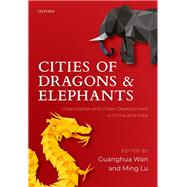Urbanization is one of the most important phenomena in economic development. In the past three decades, Asian urban populations expanded by almost one billion, a figure expected to double in the next three decades. Clearly, both the scale and pace of urbanization in Asia is unprecedented in human history and will dominate the global urbanization landscape. Asia's urbanization, in turn, is dominated by what is happening in China and India, the two most populous, fastest growing economies in the world.
Cities of Dragons and Elephants: Urbanization and Urban Development in China and India aims at addressing the two most fundamental issues of urbanization: why and where to urbanize. Contributed by a team of top experts from both countries, it uses original research to explore both the speed and scale of urbanization and urban systems or spatial distribution of urbanities in different-sized citites. It examines various drivers of urbanization alongside the benefits and costs and the role of markets, governments, and NGOs.
Cities of Dragons and Elephants presents evidence-based policy suggestions regarding the labor market, the land and housing market, FDI and the capital market, education, environment, poverty, and inequality. It uses the similarities betwen India and China to draw conclusions and implications of enormous relevance to many governments and institutions in Asia and beyond.








